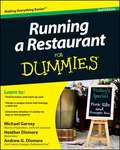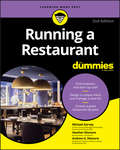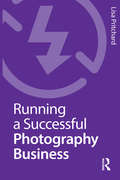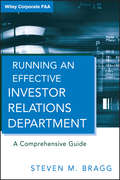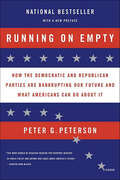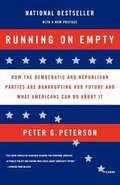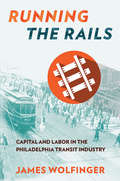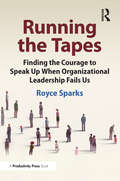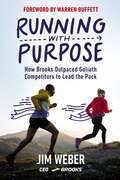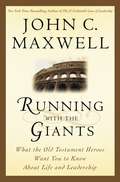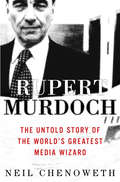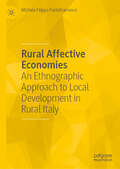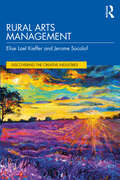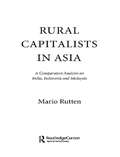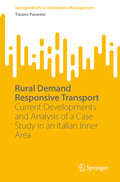- Table View
- List View
Running a Restaurant For Dummies
by Michael Garvey Andrew G. Dismore Heather H. DismoreThe easy way to successfully run a profitable restaurantMillions of Americans dream of owning and running their own restaurant -- because they want to be their own boss, because their cooking always draws raves, or just because they love food. Running a Restaurant For Dummies covers every aspect of getting started for aspiring restaurateurs. From setting up a business plan and finding financing, to designing a menu and dining room, you'll find all the advice you need to start and run a successful restaurant. Even if you don't know anything about cooking or running a business, you might still have a great idea for a restaurant -- and this handy guide will show you how to make your dream a reality. If you already own a restaurant, but want to see it get more successful, Running a Restaurant For Dummies offers unbeatable tips and advice for bringing in hungry customers. From start to finish, you'll learn everything you need to know to succeed.New information on designing, re-designing, and equipping a restaurant with all the essentials--from the back of the house to the front of the houseDetermining whether to rent or buy restaurant propertyUpdated information on setting up a bar and managing the wine list Profitable pointers on improving the bottom lineThe latest and greatest marketing and publicity options in a social-media worldManaging and retaining key staffNew and updated information on menu creation and the implementation of Federal labeling (when applicable), as well as infusing local, healthy, alternative cuisine to menu planningRunning a Restaurant For Dummies gives you the scoop on the latest trends that chefs and restaurant operators can implement in their new or existing restaurants.
Running a Restaurant For Dummies
by Michael Garvey Heather Dismore Andrew G. DismoreRunning a Restaurant For Dummies (9781119605454) was previously published as Running a Restaurant For Dummies (9781118027929). While this version features a new Dummies cover and design, the content is the same as the prior release and should not be considered a new or updated product. The easy way to successfully run a profitable restaurant Millions of Americans dream of owning and running their own restaurant — because they want to be their own boss, because their cooking always draws raves, or just because they love food. Running a Restaurant For Dummies covers every aspect of getting started for aspiring restaurateurs. From setting up a business plan and finding financing, to designing a menu and dining room, you'll find all the advice you need to start and run a successful restaurant. Even if you don't know anything about cooking or running a business, you might still have a great idea for a restaurant — and this handy guide will show you how to make your dream a reality. If you already own a restaurant, but want to see it get more successful, Running a Restaurant For Dummies offers unbeatable tips and advice for bringing in hungry customers. From start to finish, you'll learn everything you need to know to succeed. New information on designing, re-designing, and equipping a restaurant with all the essentials—from the back of the house to the front of the house Determining whether to rent or buy restaurant property Updated information on setting up a bar and managing the wine list Profitable pointers on improving the bottom line The latest and greatest marketing and publicity options in a social-media world Managing and retaining key staff New and updated information on menu creation and the implementation of Federal labeling (when applicable), as well as infusing local, healthy, alternative cuisine to menu planning Running a Restaurant For Dummies gives you the scoop on the latest trends that chefs and restaurant operators can implement in their new or existing restaurants.
Running a Side Business
by Richard Stim AttorneyTurn your hobby into a profitable business and enjoy a second income. In a troubled economy, you've discovered that a single source of income just isn't enough. But how do you start and manage your new venture -- and make a profit to boot? From crafting to home repair to website design and more, if you've ever wanted to turn your hobby into a business and watch your passion generate cash, Running a Side Business is the book for you. Packed with tips, legal resources, start-up success stories and USA TODAY snapshots and infographics, you'll learn the life cycle of a business and get answers to important questions along the way. Find out how to: choose a side business that will succeed manage a full-time job while running your side business protect your personal assets keep it legal: how and where to obtain and file permits, licenses, contracts, and trademarks manage your home-based business market your new business file taxes and take deductions Plus, Running a Side Business offers guidance on selecting the right side business for you, with information about some of the most popular side businesses that have gained popularity in the last decade, including sales through eBay and Amazon, web design, blogging, Google AdSense business models, and podcasting models.
Running a Successful Photography Business
by Lisa PritchardRunning a Successful Photography Business is the definitive business bible for every professional photographer – a one-stop resource covering everything you need to know to make your business a success. This handy book contains guidance on the key areas of running your business: fine-tuning your brand, attracting new clients and keeping existing ones, costing and producing shoots, professional ethics and codes of practice, contracts, preparing a business plan, operating your business effectively, legal obligations, working with agents and agencies and how to evolve and prosper in this ever changing industry. Everything a working photographer needs to know in order for their business to flourish.Written from the unique point of view of a leading photographers’ agent, the author knows from first-hand experience what it takes to survive and succeed as a professional photographer. This book builds on the author's popular first book, Setting up a Successful Photography Business, aimed at those starting out in freelance photography.
Running an Effective Investor Relations Department
by Steven M. BraggThe ultimate guide to investor relations Your one-stop resource for everything pertaining to your company's dealings with the investment community, Running an Effective Investor Relations Department provides investor relations professionals with essential day-to-day information. From creating and properly communicating a company's investment story, to dealing with both the sell side and buy side of the investment community, to providing guidance, and the form and frequency of that guidance, this authoritative resource covers it all. Addresses every possible area of the investor relations professionIncludes chapters covering disclosure, forward-looking statements, guidance, event management, and twenty other topics Other titles by Bragg: The Vest Pocket Controller, Accounting Best Practices, Sixth Edition, and Just-in-Time Accounting, Third EditionPractical and thorough, this book offers the world-class guidance you need to effectively manage your investor relations department.
Running on Empty: How the Democratic and Republican Parties Are Bankrupting Our Future and What Americans Can Do About It
by Peter G. PetersonHow both parties are exacerbating our economic problems
Running on Empty: How the Democratic and Republican Parties Are Bankrupting Our Future and What Americans Can Do About It
by Peter G. PetersonWhen Bush came to office in 2001, the 10-year budget balance was officially projected to be at a surplus of $5.6 trillion. But after three big tax cuts, the bursting of the stock-market bubble, and the devastating effects of 9/11on the economy, the surplus has evaporated, and the deficit is expected to grow to $ 5-trillion over the next decade. The domestic deficit is only the half of it. Given our $500 billion trade deficit and our anemic savings rate, we depend on an unprecedented $2 billion of foreign capital every working day. If foreign confidence were to wane, this could lead to the dreaded hard landing.Peter G. Peterson--a lifelong Republican, chairman of the Blackstone Group, and former secretary of commerce under Nixon--shatters the myths with hard facts and a harrowing view of the twin deficit's real impact. Republicans and Democrats alike have mortgaged America's future through reckless tax cuts, out-of-control spending and Enron-style accounting in Congress. And the situation will only get worse as the Baby Boom generation begins to retire, making unprecedented demands on entitlement programs like Social Security and Medicare. Despite what Bush says, we are on a path that could end in economic meltdown, and we simply cannot grow out of the deficit.In Running On Empty, Peterson sounds the warning bell and prescribes a set of detailed solutions which, if implemented early, will prevent the need for draconian measures later. He takes us behind the politicians' smoke-and-mirror games, and forcefully explains what we must do to rescue the future of our country.
Running on Empty: How the Democratic and Republican Parties Are Bankrupting Our Future and What Americans Can Do about It
by Peter G. PetersonThis book offers America not only a vision but the practical steps by which to ensure our children's economic future. Running on Empty is not only a warning, it is also a manifesto calling for the next administration to finally confront a deep and disturbing problem that politicians of all parties have insisted on ignoring for too long.
Running the Numbers: A Practical Guide to Regional Economic and Social Analysis
by John QuinternoThrough use of practical examples and a plainspoken narrative style that minimises the use of maths, this book demystifies data concepts, sources, and methods for public service professionals interested in understanding economic and social issues at the regional level. By blending elements of a general interest book, a textbook, and a reference book, it equips civic leaders, public administrators, urban planners, nonprofit executives, philanthropists, journalists, and graduate students in various public affairs disciplines to wield social and economic data for the benefit of their communities. While numerous books about quantitative research exist, few focus specifically on the public sector. Running the Numbers, in contrast, explores a wide array of topics of regional importance, including economic output, demographics, business structure, labour markets, and income, among many others. To that end, the book stresses practical applications, minimises the use of maths, and employs extended, chapter-length examples that demonstrate how analytical tools can illuminate the social and economic workings of actual American regions.
Running the Rails: Capital and Labor in the Philadelphia Transit Industry
by James WolfingerPhiladelphia exploded in violence in 1910. The general strike that year was a notable point, but not a unique one, in a generations-long history of conflict between the workers and management at one of the nation's largest privately owned transit systems. In Running the Rails, James Wolfinger uses the history of Philadelphia’s sprawling public transportation system to explore how labor relations shifted from the 1880s to the 1960s. As transit workers adapted to fast-paced technological innovation to keep the city’s people and commerce on the move, management sought to limit its employees’ rights. Raw violence, welfare capitalism, race-baiting, and smear campaigns against unions were among the strategies managers used to control the company’s labor force and enhance corporate profits, often at the expense of the workers’ and the city’s well-being. Public service workers and their unions come under frequent attack for being a "special interest" or a hindrance to the smooth functioning of society. This book offers readers a different, historically grounded way of thinking about the people who keep their cities running. Working in public transit is a difficult job now, as it was a century ago. The benefits and decent wages Philadelphia public transit workers secured—advances that were hard-won and well deserved—came as a result of fighting for decades against their exploitation. Given capital’s great power in American society and management's enduring quest to control its workforce, it is remarkable to see how much Philadelphia’s transit workers achieved.
Running the Tapes: Finding the Courage to Speak Up When Organizational Leadership Fails Us
by Royce SparksThis practical and accessible exploration of ethics in organizational leadership contains several underlying themes: first, that even the most morally stalwart organizations are vulnerable to the ethical challenges that come from failings of leadership, particularly executive leadership. A great focus today is being paid to the idea of toxic work environments, and while explorations of culture, team building, and language are all valuable pieces of this discussion, at its heart this is a question of leadership. Stripping away authority as a requisite for leadership empowers everyone at all levels of an organization to take a higher level of ownership over their leadership skills, to become a voice of action and protection for their teammates and the organization when the conventional safeguards of the workplace fail them. The common term for these individuals may be whistleblowers, but rather, are they instead models of leadership that organizations should be paying closer attention to? By drawing a constant dividing line between ethics and organizational interests, have we been missing a key middle ground this entire time? By redefining the boundaries of leadership through the lens of how to take action in a hostile workplace environment, this book offers a series of accessible strategies, principles, and examples that can be easily followed regardless of rank or position. Based on his consulting work, the author recounts actual ethical investigations of egregious workplace violations. To make this book even more valuable, the author offers strategies for how to parse grievances from genuine wrongdoings, make decisions about how to handle delicate information, choose allies wisely, and prepare for both the consequences and sometimes benefits of bringing organizational wrongdoings to light. Finally, this book aims to inspire courage, nurture leadership growth at all levels, and offer leaders in positions of power a clear case for why opting for environments of ethical accountability is synonymous, rather than at odds, with an organization’s self-interest.
Running the World's Markets: The Governance of Financial Infrastructure
by Ruben LeeThe efficiency, safety, and soundness of financial markets depend on the operation of core infrastructure--exchanges, central counter-parties, and central securities depositories. How these institutions are governed critically affects their performance. Yet, despite their importance, there is little certainty, still less a global consensus, about their governance. Running the World's Markets examines how markets are, and should be, run. Utilizing a wide variety of arguments and examples from throughout the world, Ruben Lee identifies and evaluates the similarities and differences between exchanges, central counter-parties, and central securities depositories. Drawing on knowledge and experience from various disciplines, including business, economics, finance, law, politics, and regulation, Lee employs a range of methodologies to tackle different goals. Conceptual analysis is used to examine theoretical issues, survey evidence to describe key aspects of how market infrastructure institutions are governed and regulated globally, and case studies to detail the particular situations and decisions at specific institutions. The combination of these approaches provides a unique and rich foundation for evaluating the complex issues raised. Lee analyzes efficient forms of governance, how regulatory powers should be allocated, and whether regulatory intervention in governance is desirable. He presents guidelines for identifying the optimal governance model for any market infrastructure institution within the context of its specific environment. Running the World's Markets provides a definitive and peerless reference for how to govern and regulate financial markets.
Running with Purpose: How Brooks Outpaced Goliath Competitors to Lead the Pack
by Jim WeberDiscover how Brooks Running Company CEO Jim Weber transformed a failing business into a billion-dollar brand in the ultracompetitive global running market. Running with Purpose is a leadership memoir with insights, inspirational stories, and tangible takeaways for current and aspiring leaders, entrepreneurs, and the 150+ million runners worldwide and those in the broader running community who continually invest in themselves.This leadership memoir starts with Jim Weber's seventh-grade dream to run a successful company that delivered something people passionately valued. Fast forward to 2001, Jim became the CEO of Brooks and, as the struggling brand's fourth CEO in two years, he faced strong headwinds. A lifelong competitor, Jim devised a one-page strategy that he believed would not only save the company but would also lay the foundation for Brooks to become a leading brand in the athletic, fitness, and outdoor categories. To succeed, he had to get his team to first believe it was possible and then employ the conviction, fortitude, and constancy of purpose to outperform larger brands. Brooks' success was validated when Warren Buffett made it a standalone Berkshire Hathaway subsidiary in 2012. In the pages of Running with Purpose, you will find:Brooks&’ bold strategy and unique brand positioning that fueled its move from the back of the pack to lead.The key to building a purpose-driven brand that is oriented around customer obsession, building trust, competing with heart, and having fun along the way.The six clear leadership lessons Jim has learned along his path and applies at Brooks to develop staff into authentic leaders.How Berkshire Hathaway's support and influence provided a tailwind for Brooks' business and brand to surge.An inside look at the ups and downs of Jim's personal journey, which led to his conviction that life is too short not to enjoy what you do and the people by your side.
Running with the Giants: What the Old Testament Heroes Want You to Know About Life and Leadership (Giants of the Bible)
by John C. MaxwellMotivational guru John C. Maxwell finds inspiration and encouragement in the lives of Old Testament personalities.
Rupert Murdoch: The Last Tycoon
by Geoffrey G. Jones Hari BalkrishnaThe case examines the entrepreneurial career of Rupert Murdoch, and the growth of News Corporation from a small Australian newspaper to a global media giant. It shows how he expanded geographically to Europe, the United States, and Asia and from newspapers to the film and television industries. The case identifies the personal role of Murdoch in this growth, and the role of his family in its management. The case considers the political impact of News Corporation's newspapers and other media, and their alleged role in shaping political opinion.
Rupert Murdoch: The Untold Story of the World's Greatest Media Wizard
by Neil ChenowethIf you want to understand how modern media has changed the world, this is the one book you must read. Rupert Murdoch is the man everyone talks about but no one knows. He's everywhere, a larger-than-life media titan who has spent a lifetime building his company, News Corporation, from a small, struggling newspaper business in Australia into an international media powerhouse. Rupert Murdoch charts the real story behind the rise of News Corp and the Fox network: the secret debt crises and family deals, the huge cash flows through the offshore archipelagos, the New York party that saved his empire, the covert government inquiries, the tax investigations, and the bewildering duels with Bill Gates, Ted Turner, Gerry Levin, Ron Perelman, Newt Gingrich, cable king John Malone, Michael Eisner, Tony Blair, and televangelist-turned-diamond-miner Pat Robertson. Murdoch's story, however, is more than just how one man built a global business. Rupert Murdoch is both a biography of Murdoch the man (including the divorce from his wife, Anna; his remarriage to a woman young enough to be his granddaughter; and the struggle between his two sons for eventual control of the family holdings) and a "follow the money" investigation that reveals how he has managed to have such a huge impact on the communications revolution that promises to utterly transform life in the twenty-first century. The investigation concentrates on Murdoch's three great campaigns: in the 1980s, when his determination to launch an American television network overturned the media industries of three countries; in 1997, when Murdoch took on every broadcasting group in America; and the process of reinventing himself since then, culminating in his bid to win DirecTV from General Motors. This is the saga of the man who has stalked, infuriated, cajoled, threatened, and spooked the media industry for three decades, whose titanic gambles have shaped and reshaped the media landscape. Win or lose, Murdoch is the man who has changed everything. And Neil Chenoweth is the right person to tell the story: In 1990 he wrote a magazine article that prompted a secret Australian government inquiry into Rupert Murdoch's family companies, and he's been on the Murdoch case since then. Chenoweth reveals what no person ever has about the man (and the company) who is probably the most significant media player of them all.
Rural Affective Economies: An Ethnographic Approach to Local Development in Rural Italy
by Michele Filippo FontefrancescoThis book delves into the development trajectories of rural Europe, with a specific focus on Italy. The book addresses the key challenges rural communities face and explores the potential for grassroots development. The concept of affective economy is central to the book, which is introduced and utilized to analyze these dynamics. The book assesses local food heritage and agrifood chains to showcase how these elements can serve as pillars for sustainable local development. It provides tools and methodologies for identifying and documenting food heritage, offering practical insights for public and private stakeholders interested in fostering local economic growth, and shows how emotional and social bonds within communities can drive sustainable growth. This book is a must-read for academics and practitioners passionate about sustainable development who want to envision concrete strategies for rural development.
Rural Arts Management (Discovering the Creative Industries)
by Elise Lael Kieffer Jerome SocolofThe arts and arts management exist in every corner of the world, from the largest city to the smallest town. However, just as a metropolis and a hamlet bear little resemblance to each other despite similar basic needs, arts organizations in the former frequently bear little resemblance to those in the latter, and many foundational arts management texts give little attention to rural settings. This book combines insights from research and practice to fill that knowledge gap and help readers understand arts administration in rural communities.Focusing on the North American setting but including comparative examples and references from around the world, this book examines how areas of practice familiar to any arts manager work in rural areas, including research and best practices for navigating the paucity of resources frequently encountered in rural communities. Emphasizing a “by rural, for rural” perspective, this book frames the arts as integral components of vibrant rural communities and valuable tools for meeting these communities’ needs.Written by arts and nonprofit management professors with backgrounds in rural arts research and practice, this book provides a valuable resource for scholars, advanced students and reflective practitioners at the intersection of the arts and rural studies.
Rural Built Environment of Sichuan Province, China
by Yibin Ao Igor MartekMajor changes are taking place in the Chinese countryside as China rushes to modernizes and urbanizes its rural fabric. The transformation is improving the quality of life of rural inhabitants, but also brings about challenges as people strive to adjust. This book systematically examines the impact of change on the daily lives and activities of the residents of Sichuan Province, in China’s South-west. It examines the themes of infrastructure, transport modes and preferences, sanitation, water conservation, earthquake and flood disaster preparedness, and the impact these have on villager behavior and quality of life. This book is an essential reference guide for graduate students and practitioners in the fields of rural planning, renewal, and construction.
Rural Capitalists in Asia: A Comparative Analysis on India, Indonesia and Malaysia (Nias Monographs #No. 88)
by Mario RuttenThis is a comparative study of small capitalists and rural industrialists in three Asian countries. Studies on the entrepreneurial class in South Asia tend to focus on the structural aspects of entrepreneurial behaviour, while studies on this class in Southeast Asia tend to focus on cultural aspects of their behaviour. In fact, this book points to striking similarities between Indian, overseas Chinese and Muslim businessmen in Asia, similarities usually hidden under variations in analytical approaches. Although this study emphasizes similarities within Asia, it does not support the view of a specific Asian business pattern different to the rise of non-Asian, especially European, entrepreneurs. The findings are of major interest not just within the fields of anthropology and entrepreneurship, but to all scholars working on South or Southeast Asia, who will find much of interest in the author's observations of variable research results between the two regions.
Rural China: Economic and Social Change in the Late Twentieth Century (Studies On Ethnic Groups In China Ser.)
by Thomas Heberer Jie Fan Wolfgang TaubmannThis book reports the findings of two field studies conducted between 1993 and 2001 in seven townships and six provinces in China. The authors describe the process of rural urbanization and its related economic, social, and political changes by focusing mainly on the zhen (town), in addition to administrative offices and companies involved in the local economy, and village committees. The authors show that the social changes resulting from China's economic reforms are occurring mainly from below, and that this process is also resulting in a weakening of the economic and political dominance of the central government. Other changes discussed in this study include the development of new ownership structures and the increasing dominance of the private sector; a shift in the functions of administrative offices as the bureaucracy becomes increasingly business oriented; the rise of a new local elite; a rebirth of traditional social structures (clans, local associations); and the emergence of new interest groups and institutions to represent their needs.
Rural Demand Responsive Transport: Current Developments and Analysis of a Case Study in an Italian Inner Area (SpringerBriefs in Operations Management)
by Tiziano PavaniniThis book analyzes the transport situation in so-called low-demand areas, i.e., rural areas where traditional public transport is often poor and inefficient. Though rural transport has largely been neglected in the literature in favor of more urbanized contexts, it is often the only mobility option for the many citizens who still live in these areas. This book aims to fill the gap in the literature by providing further insights into rural transport research, in particular by presenting a valid solution: Demand Responsive Transport (DRT). This widespread technology allows public transport authorities to make their journeys more efficient by maximizing the load factor of vehicles, while helping citizens meet their mobility needs. The book addresses key research questions concerning the strengths and weaknesses of deploying Demand-Responsive Transport (DRT) in rural areas; mayors&’ perceptions regarding the transport characteristics of their regions; and the evaluation of a DRT pilot project. These aspects are explored through a case study of DRT implementation in two rural areas near the Ligurian cities of Chiavari and Genoa.
Rural Development and Urban-Bound Migration in Mexico (Routledge Revivals)
by Pierre Crosson Arthur SilversRapid growth of urban populations is a major characteristic of economic development and demographic change in developing countries leading to industrialisation and modernisation of major cities. Originally published in 1980, this study focusses on these issues using Mexico as a case study as well as analysing the risk of over-urbanisation and what the effects will be on cities such as Mexico City. This title will be of interest to students of Environmental studies and Economics.
Rural Development and the Construction of New Markets (Routledge ISS Studies in Rural Livelihoods)
by Jan Douwe van der Ploeg Paul Hebinck Sergio SchneiderThis book focuses on empirical experiences related to market development, and specifically new markets with structurally different characteristics than mainstream markets. Europe, Brazil, China and the rather robust and complex African experiences are covered to provide a rich multidisciplinary and multi-level analysis of the dynamics of newly emerging markets. Rural Development and the Construction of New Markets analyses newly constructed markets as nested markets. Although they are specific market segments that are nested in the wider commodity markets for food, they have a different nature, different dynamics, a different redistribution of value added, different prices and different relations between producers and consumers. Nested markets embody distinction viz-a-viz the general markets in which they are embedded. A key aspect of nested markets is that these are constructed in and through social struggles, which in turn positions this book in relation to classic and new institutional economic analyses of markets. These markets emerge as steadily growing parts of the farmer populations are dedicating their time, energy and resources to the design and production of new goods and services that differ from conventional agricultural outputs. The speed and intensity with which this is taking place, and the products and services involved, vary considerably across the world. In large parts of the South, notably Africa, farmers are ‘structurally’ combining farming with other activities. By contrast, in Europe and large parts of Latin America farmers have taken steps to generate new products and services which exist alongside ongoing agricultural production. This book not only discusses the economic rationales and dynamics for these markets, but also their likely futures and the threats and opportunities they face.
